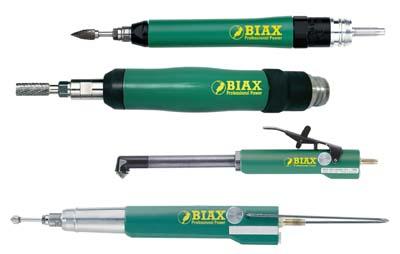
Dapra's series of Biax hand-held, air-powered tools include lightweight grinders and variable-speed deburring machines. The SRD 3-55/2 and SRD 6-30/2 are ideal for grinding and shaping. The SRD 3-55/2 features a low-vibration motor for fine deburring and long service life. Its rotational speed is 55,000 RPM with an air consumption of 6 CFM. The SRD 6-30/2 high-performance grinder has a 150-Watt motor and achieves a speed of 30,000 RPM. Both lightweight grinders have twist valves and are designed for easier handling to reduce user fatigue.
Dapra also offers straight and angled variable-speed, hand-held deburring tools. The angular design of models BEW 309 and BEW 605 is ideal for deburring bore holes in difficult-to-reach areas, such as slanted bore holes that must be deburred from the inside. The BEW 309 has a variable speed of 0-900 RPM; the BEW 605 has a variable speed of 0-500 RPM. Both models have a lever valve and a backward air exhaust direction. The Biax BE 309 straight drilling/deburring machine deburrs bore holes up to 5.5mm and has a variable speed of 0-900 RPM. The tool has a push-start valve for easier handling.
Contact Details
Related Glossary Terms
- fatigue
fatigue
Phenomenon leading to fracture under repeated or fluctuating stresses having a maximum value less than the tensile strength of the material. Fatigue fractures are progressive, beginning as minute cracks that grow under the action of the fluctuating stress.
- grinding
grinding
Machining operation in which material is removed from the workpiece by a powered abrasive wheel, stone, belt, paste, sheet, compound, slurry, etc. Takes various forms: surface grinding (creates flat and/or squared surfaces); cylindrical grinding (for external cylindrical and tapered shapes, fillets, undercuts, etc.); centerless grinding; chamfering; thread and form grinding; tool and cutter grinding; offhand grinding; lapping and polishing (grinding with extremely fine grits to create ultrasmooth surfaces); honing; and disc grinding.
- shaping
shaping
Using a shaper primarily to produce flat surfaces in horizontal, vertical or angular planes. It can also include the machining of curved surfaces, helixes, serrations and special work involving odd and irregular shapes. Often used for prototype or short-run manufacturing to eliminate the need for expensive special tooling or processes.
